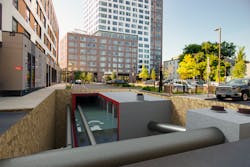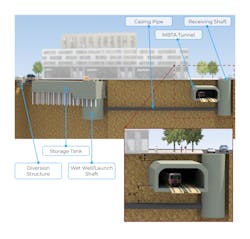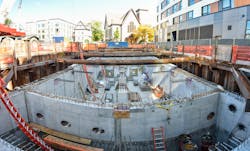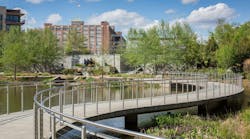Stormwater Management for Resilient Communities
From rising temperatures to increasing extreme weather events, climate change is affecting the world in which we live. One effect of the changing climate is that it’s raining more frequently — and more intensely — than ever before, wreaking havoc on infrastructure and, more specifically, on urban populations and thoroughfares.
In The Port neighborhood in the City of Cambridge, Mass., residential homes and businesses suffer an increased risk of flooding and sanitary sewer backups in residential homes due to these more frequent and intense rain events. This neighborhood comprises a high number of low-income residents and residents who primarily speak a language other than English. Based on the City of Cambridge’s recent assessments on climate change vulnerability, these populations tend to be more at risk from the impacts of climate change.
The stormwater within The Port neighborhood historically flowed to the Massachusetts Water Resource Authority’s (MWRA) combined sewer system, which has limited capacity to manage flows from today’s large storm events. Because of this, the neighborhood has experienced significant surface flooding and sanitary sewer backups in the past, and climate change will only increase flood risk and exacerbate impacts to the neighborhood.
As such, the City of Cambridge constructed the Parking Lot No. 6 Stormwater Tank, drainage infrastructure in Massachusetts Avenue — both a complex utility and urban traffic corridor — that enabled separated stormwater to be directed to the Charles River, rather than to the overburdened MWRA combined sewer, with the intent of reducing future flooding issues in The Port neighborhood.
The tank is Phase 1 of the City’s multiphase resiliency plan in The Port. While the tank presented many challenges and innovations in its design and construction, its contributions and value to the community and future engineering endeavors have set a positive tone for the infrastructure improvements that lie ahead for the neighborhood.
Port Flooding Resiliency Project: Parking Lot No. 6 Stormwater Tank
Kleinfelder — an engineering, design, construction management, construction materials inspection and testing, and environmental services firm — served as the lead consultant for the project and worked closely with the City of Cambridge’s Department of Public Works to design a 390,000-gallon, 119-by-36-foot cast-in-place underground stormwater tank, located in the city-owned Parking Lot No. 6 (PL6).
Kleinfelder and subconsultant Stantec needed to apply innovative, creative engineering solutions to overcome multiple challenges associated with crossing the century-old Massachusetts Bay Transportation Authority (MBTA) Red Line subway tunnel, construction of subsurface infrastructure in soft Boston Blue Clay soils, and the simultaneous construction of a commercial development (Market Central) along the east and south sides of PL6, limiting tank construction access.
A Historic Divide
One of the unique aspects of implementing this project was that standing between the PL6 stormwater tank and the existing Massachusetts Avenue storm drain is the MBTA’s Red Line subway tunnel. The shallow, 100-year-old tunnel has historically presented a divide for stormwater catchments and subsurface utilities along Massachusetts Avenue, requiring redundant utilities on both the north and south side of the congested corridor.
Constructed in 1910, the Red Line tunnel is 23 feet deep with limited as-built information. Faced with less than 2 feet of cover between the road surface and the roof of the train tunnel and major structural concerns with a tunnel crossing, the Kleinfelder team conducted an extensive alternatives evaluation and devised multiple design iterations.
A Complex Connection
Working in collaboration with the MBTA, Kleinfelder proposed a connection from the new PL6 stormwater tank to the storm drain by microtunneling 200 feet of 72-inch Permalock steel casing pipe — carrying four, 18-inch force mains — beneath the active MBTA Red Line subway tunnel.
Siting an access shaft for the microtunnel boring machine was another complication of this trenchless solution.
Advancing the tunnel within difficult ground conditions due to weight-of-hammer Boston Blue Clay was an added challenge, and the subway tunnel was at high risk of damage from differential movement.
To alleviate these obstacles, the Kleinfelder team performed a geotechnical analysis to evaluate the potential for vertical movement under short-term temporary construction conditions and long-term permanent conditions for the 100-year design life of the final permanent structures. The team incorporated extensive real-time geotechnical monitoring to record soil movement, continuous monitoring of the MBTA subway tracks, and pre- and post-construction structural inspections of the MBTA Red Line tunnel to ensure the specified critically low movement tolerances were met and confirmed the structural integrity of the portion of MBTA tunnel potentially influenced by the microtunnel operation.
Adding to the challenges during construction was the simultaneous construction of a new Market Central development project — including two towers, 6 and 19 stories high — surrounding PL6. The 20-foot-deep stormwater storage tank would be constructed only 8 feet away from one of the tower’s building foundations while the trenchless utility corridor was less than 3 feet away from both towers.
The Kleinfelder team, general contractor Skanska Civil USA, and the tunneling contractor SECA Underground Corporation, worked in collaboration to overcome each challenge with a collective engineering solution and modifications to the tunneling approach, circumnavigating beneath the MBTA Red Line crossing without service disruption.
Community Awareness
Throughout the design and construction process, Kleinfelder and the City engaged with The Port community in defining a plan for the project and garnering interest and enthusiasm. Due to the various languages spoken in the community, as well as the potential for dense technical language, it was necessary to ensure stakeholder materials were clear, translated correctly, and shared in prominent locations — including the multiple churches in the neighborhood, the community arts center, and the Margaret Fuller House, a provider of youth and food services and community advancement.
The team has been able to showcase the project’s progress at recent community events, like Port Pride Day and the Port Party, resulting in a sharp increase in enthusiasm and support from stakeholders for future Port infrastructure improvement phases and engineering efforts in general.
Project Success
After the successful completion of the complex design and construction process, the tank became operational in May 2021 and redirected more than 3,480,000 gallons of stormwater from The Port neighborhood during the Boston area’s third-wettest summer on record with over 19 inches of rain. The PL6 stormwater tank successfully eliminated the surface flooding that impacted the neighborhood during similar-sized storm events prior to the tank installation.
“This project serves as an example of how municipalities can mitigate the effects of climate change that often harm populations most at risk in our communities, while setting the stage for future improvements, benefiting the community for generations to come,” Assistant Commissioner and City Engineer for the City of Cambridge Kathy Watkins said.
The success of the project has generated public interest, allowing for a fruitful and positive transition to other Port neighborhood infrastructure improvement efforts needed to meet the city’s goals for flood resiliency. The installed 72-inch casing pipe, for example, includes the piping to connect two additional future tanks to existing stormwater and sanitary sewer infrastructure on Massachusetts Avenue to meet resiliency goals for The Port neighborhood.
The project also received recognition through the American Council of Engineering Companies (ACEC) Massachusetts chapter. SW
Katherine Goyette is a senior project manager at Kleinfelder with 24 years of experience in the planning, design, and construction of complex urban wastewater and stormwater infrastructure. She led the planning, design, and construction of the Parking Lot No. 6 Stormwater Tank project and is leading the consequent phases of Cambridge’s Flooding Resiliency Project.
Muriel Wixson is an outreach and engagement specialist at Kleinfelder, prior to which she served as a news editor and reporter. She is helping to lead the outreach and engagement efforts for Cambridge’s Flooding Resiliency Project.
Published in Stormwater magazine, February 2022.
About the Author
Muriel Wixson
Muriel Wixson is an outreach and engagement specialist at Kleinfelder, prior to which she served as a news editor and reporter. She is helping to lead the outreach and engagement efforts for Cambridge’s Flooding Resiliency Project.
Katherine Goyette
Katherine Goyette is a Senior Project Manager at Kleinfelder with 24 years of experience in the planning, design, and construction of complex urban wastewater and stormwater infrastructure. Katherine led the planning, design, and construction of the Parking Lot No. 6 Stormwater Tank project and is leading the consequent phases of Cambridge's Flooding Resiliency Project.





